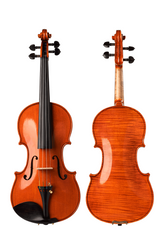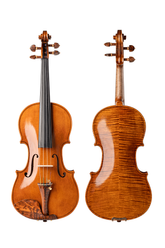Guarneri Family: Renowned Violin Makers of Cremona
In the history of violin making in Cremona, Italy, there is a family that spans three generations and produced five master violin makers, among whom the most famous is considered on par with the renowned Stradivari. Even today, people are still pursuing their legendary creations. They are the Guarneri Family.
Table of Contents
- Guarneri Violin Making Family
- Andrea Guarneri(1626-1698)
- Pietro Giovanni Guarneri (Pietro da Mantova) (1655–1720)
- Giuseppe Giovanni Battista Guarneri ;Joseph Guarnerius Filius Andreae (1666–1739 or 1740)
- Petro Guarneri(1695–1762)
- Bartolomeo Giuseppe Guarneri (del Gesù) (1698–1744)
- Fiddlover Brings Famous Violins Back to Life
Guarneri Violin Making Family
The Guarneri family is renowned, even among the distinguished Italian makers. The founder of the family was Andrea Guarneri (1626-1698), who had two sons who inherited his craft: Pietro Giovanni Guarneri (Pietro da Mantova) (18 February 1655 – 26 March 1720) and Giuseppe Giovanni Battista Guarneri; Joseph Guarnerius Filius Andreae (25 November 1666 – 1739 or 1740). Joseph had two sons who also pursued violin making, namely Petro Guarneri (Petro Guarneri of Venice) (14 April 1695 – 7 April 1762) and the most famous genius of the family, Bartolomeo Giuseppe Guarneri (del Gesù) (21 August 1698 – 17 October 1744). All five of them were masterful violin makers.
Andrea Guarneri(1626-1698)
Andrea Guarneri, the founder of the Guarneri family, was a student of Nicolaus Amati (1596-1684) and worked in his workshop during his apprenticeship and early career. He collaborated with his master for nearly 20 years, during which Nicolaus was at the peak of his career, and he was regarded as the true heir by his master. In fact, his name appeared in the Amati family genealogy in 1641, which was quite different from his fellow apprentices. During the same period, Antonio Stradivari was also an apprentice of Nicolaus, but they did not achieve the same status as Andrea Guarneri. Although Andrea did not reach the heights of his master, he remained a loyal follower, and many of his works were marked as student of Nicolaus Amati. Eventually, he became a masterful violin maker and founded the Guarneri family.
Andrea had two sons who inherited his violin-making craftsmanship, namely Pietro Giovanni Guarneri and Joseph Guarnerius Filius Andreae.
Pietro Giovanni Guarneri (Pietro da Mantova) (1655–1720)
It is obvious that both brothers acquired their skills from their father, but unlike his brother Joseph, he did not continue working with their father. He left Cremona in 1679 and moved to Mantua, which proved to be a wise decision as, during that time, Cremona was dominated by Antonio Stradivari, who overshadowed all other violin makers of that era. Joseph had a son named Pietro, who was referred to as "Pietro of Mantua" because he moved there, while his nephew was usually referred to as "Pietro of Venice" (as he also left Cremona).
Pietro Giovanni Guarneri was not only a violin maker, but also a cultured musician and renowned string maker. After arriving in Mantua, he found success as he did not have to compete with Stradivari, but his multiple roles led to him producing very few instruments. Despite his professional success, he did not have time to train his successors. However, his violin-making techniques influenced his brother and nephew. Moreover, his decision to leave his father was deeply resented by his father, Andrea, who did not forgive him until his death, which was a great regret.
Giuseppe Giovanni Battista Guarneri ;Joseph Guarnerius Filius Andreae (1666–1739 or 1740)
Joseph, unlike his brother Pietro, spent his entire life in Cremona, even though it brought him difficulties. He started as an apprentice, became a violin maker, and eventually inherited his father's workshop. He followed in his father's footsteps, remaining loyal to the Amati style of violin making that his father had taught him, and all his works exhibit the distinctive Guarneri tonal quality, while also being influenced by his brother Pietro.
He made violins using the uniquely Italian approach of a highly free working method, maximizing innovation in the details of his instruments, resulting in each one being distinct. Despite living almost 70 years of age, like his father, he did not produce many instruments, and their prices were relatively low, which, in the turbulent times he lived in, led to a less comfortable life compared to his brother.
After his father's death, he had to face increasingly dire circumstances. On one hand, he had to settle his father's estate with his other siblings, including his less favored brother Pietro. On the other hand, Cremona was embroiled in the war of succession for the Spanish throne, causing turbulence and instability. Furthermore, like his father, he struggled to compete with the renowned Stradivari, who was active in Cremona during the same period. These factors had a profound impact on him and his children.
His work abruptly ceased in 1720, and for the 20 years until his death, there were no new creations, which is very different from other luthiers. This remains an unsolved mystery to this day, and as later generations, we can only feel profound regret.
He also had two sons who inherited his violin-making craft, namely Petro Guarneri of Venice and Bartolomeo Giuseppe Guarneri (del Gesù).
Petro Guarneri(1695–1762)
He was the last violin maker of the Guarneri family, as his brother del Gesù had passed away before him without any heirs, and he did not have any heirs. Like his uncle Pietro of Mantua, he also left Cremona and moved to Venice. Due to having the same name as his uncle, he was also known as Petro of Venice.
Unfortunately, his brother had passed away before him, and neither he nor his brother left behind any heirs. The descendants of other violin makers in Venice also did not inherit their family businesses. Just like in other parts of Italy, the golden era of violin-making has passed.
Fiddlover Violin Shop launched the CR (Classic Reappearance) series of violins in March 2023, aiming to revive the traditional Italian violin-making craftsmanship and bring it to modern violin enthusiasts. Each violin in this series is meticulously crafted using traditional violin-making techniques, based on data from famous historical violin makers. They are all one-of-a-kind, designed to capture the unique charm of ancient masterpieces in the modern era. If you wish to make a purchase, you can click on the CR (Classic Reappearance) series violins for further information.
Bartolomeo Giuseppe Guarneri (del Gesù) (1698–1744)
He was the most brilliant luthier and the only one in the history of violin-making who could rival Antonio Stradivari. Nowadays, there are two main types of violins, namely Stradivarius style and Guarneri style, with the former referring to Antonio Stradivari and the latter referring to Bartolomeo Giuseppe Guarneri (del Gesù).
Unlike his brother, he did not leave Cremona. History often repeats itself, and the circumstances of the two brothers were similar to those of their ancestors. Their uncle left Cremona, while their father stayed. In their generation, his brother also left Cremona, while he chose to stay. Both the uncle and brother who left Cremona achieved significant financial success, while the father and he, who stayed in Cremona, had to face severe economic burdens.
Unlike other famous violin makers, his life was very short, and his career in violin-making lasted only a little over 20 years. However, during this period, the violins he made left an unmatched charm and originality to the world. His violin-making style, influenced by Stradivari like his brother, also showed traces of Amati, but with flatter back and front plates, reminiscent of Martini.
Like his other family members, he had to face the dominance of Stradivari over the Cremonese violin-making industry, which made it difficult for his works to compete in terms of prices with his peers. As a result, he had to quickly produce a large number of instruments to make a living, which resulted in his works having a distinctly different style from Stradivari's.
Stradivari's works are known for their consistent style, exquisite appearance, and excellent craftsmanship, catering to wealthy collectors or nobility. On the other hand, his works have a wide range in terms of quality, with somewhat rougher craftsmanship, and they often served the needs of violinists who relied on heavy performance schedules for their livelihood. As a result, many of his works did not receive meticulous protection and suffered damage, which is undoubtedly a great regret.
In 1722, he left his father's workshop. In 1731, he started using the IHS label, which also established his style of craftsmanship. Over the next seven to eight years, he produced a large number of works. However, after 1736, his career declined, with very few works produced each year. There are rumors that during this period he was imprisoned for killing a competitor, which may have led to his declining health, and he passed away at a young age in 1744. After that, he passed away, and a generation of masters passed away, leaving too much regret and unwillingness.
Fiddlover Brings Famous Violins Back to Life
History has passed, but classics can be revived. The CR series is the latest violin series introduced by Fiddlover, symbolizing the revival of classics. Currently, it focuses on reproducing the works of Stradivari and del Gesù. Below are the details of two violins from the CR series:

Fiddlover Classic Reappearance Strad 1716 Violin (CR600) (click to buy)
Price: $3900
Top: Italian spruce with a hundred-year-old growth and naturally air-dried for 25 years
Back, rib, and headstock: Bosnian maple with a growth of over a hundred years and naturally air-dried for 25 years
Fittings: Ebony
Bridge: French Aubert(LUXE)(Titanium Metal Bridge Clip)
Strings: Austrian Thomastik Infeld Vienna Vision VI100
Color: Brownish yellow
Varnish: Pure oil-based amber varnish
Model: Strad 1716
Craftsmanship: Italian traditional Purfling First technique, independently handmade by master luthiers

Fiddlover Classic Reproduction Cannone 1743 Violin (CR200) (click to buy)
Price: $2800
Top: European spruce from the Alps, naturally air-dried for 15 years
Back, rib, and headstock: Bosnian maple, naturally air-dried for 15 years
Fittings: Brazilwood
Bridge: French Aubert (Titanium Metal Bridge Clip)
Strings: Austrian Thomastik Infeld Vienna Vision VI100.
Color: Brown-red
Varnish: Pure oil-based amber varnish
Model: Guarneri Del Gesú Il Cannone 1743 violin
Craftsmanship: Italian traditional Purfling First technique, handmade by master luthiers





